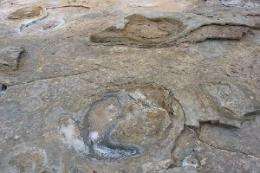Broome dinosaur footprints detail substrate deformation unique on Earth

Two recent papers by palaeontologists working north of Broome highlight a new approach to the study of dinosaur footprints.
A previous, more taxonomic, approach to dinosaur ichnology focused on the collection and study of "museum grade" footprints which were used to identify dinosaur species and some of the individual dinosaur's physiological characteristics, such as size and mass.
Studies of the Broome dinosaur track way by palaeontologists McCrea, Lockley et al (2011), and Thulborn (2012), point to an emerging trend, the study of dinosaur interactions.
"Even poorly preserved prints can be useful for census purposes and for analysing foot/sediment interactions," says Indiana-Purdue University palaeontologist Prof James O. Farlow in his peer-review of the McCrea paper.
The Broome trackway was once an early Cretaceous shoreline, frequented by at least 15 dinosaur species that regularly walked in the moist intertidal sands and estuarine mud.
When conditions were right these solidified into sandstone, preserving footprints for posterity along much of the Dampier Peninsula's west coast.
The sandstone would then often be covered by further layers of sand on which dinosaurs, in turn, would leave more tracks.
As a result the Broome sandstone often comprises several layers of sediment, each containing underprints or "ghost prints".
"The patterns of deformation created by sauropods traversing thinly-stratified lagoonal deposits of the Broome Sandstone are unprecedented in their extent and structural complexity," Dr Thulborn says in his paper.
"The stacks of transmitted reliefs … beneath individual footfalls are nested into a hierarchy of deeper and more inclusive basins and troughs which eventually attain the size of minor tectonic features.
"Ultimately the sauropod trackmakers deformed the substrate to such an extent that they remodelled the topography of the landscape they inhabited.
"Such patterns of substrate deformation are revealed by investigating fragmentary and eroded footprints, not by the conventional search for pristine footprints on intact bedding planes.
"For that reason it is not known whether similar patterns of substrate deformation might occur at sauropod track-sites elsewhere in the world."
Queensland University palaeontologist Dr Steve Salisbury says the Broome sandstone is about 200 kilometres long and contains Australia's most important dinosaur track way, the next most important being at Lark Quarry in Queensland.
The latter is about the size of a tennis court with tracks of only two or three dinosaur species preserved.
Dr Salisbury has written a new paper on the Broome Sandstone dinosaur trackway which is currently subject to peer review.
Provided by Science Network WA




















